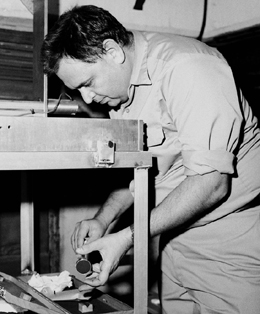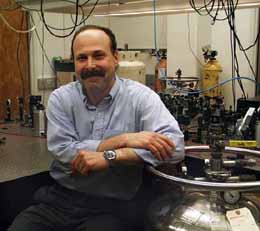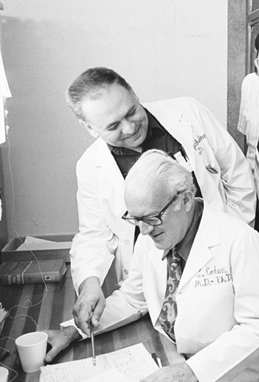 |
|
Adding His Own Spin Colloquium speaker David Awschalom revisits scene of his early training, and his father's contributions by Mike Perricone
For David Awschalom, education wasn’t limited to school hours. He had the advantages of two unique environments: his father was noted physicist Miguel Awschalom; his summer jobs in the late 1970s had him working with electronics at Fermilab. “I worked in both physical electronics and computer programming,and that had a substantial impact in my choosing physics as a career,”said Awschalom, now a professor of physics at the University of California at Santa Barbara,and director of the University of California Center for Spintronics and Quantum Computing. “I remember enjoying it thoroughly,”he said of his Fermilab experience.“I remember enjoying the atmosphere in the laboratory,and trying to understand as much as I could in the seminars.It was one of my first opportunities for an immersion in the world of computing,and to see the full impact of small- scale and large-scale computation in the world of science.” Awschalom will return to his early surroundings to offer the Fermilab Colloquium on Wednesday, June 11,speaking on spintronics — using an electron’s property of spin, as well as its charge, to exploit quantum effects in information technology. “So in a sort of odd way,” he said,“I’ve come full circle — I’m now working in both fundamental physics and in computer science,through quantum information processing.” In his June 2002 article in Scientific American, Awschalom stated his belief that “we are being offered an unprecedented opportunity to define a radically new class of device that would exploit the idiosyncrasies of the quantum world to provide unique advantages over existing information technologies.”Most laptop computers,he explained,already rely on a spintronic effect called giant magnetoresistance (GMR)to read high-capacity hard drives storing huge amounts of data.He traced the phenomenon of magnetoresistance —a change in electrical resistance caused by a magnetic field —back to its use in the earliest computer hard drives,to read data stored in magnetic domains.
In just a year since the article was published, Awschalom noted two significant advances in spintronics. The first was the unexpected development of exploiting nuclear spins —not just particle spins —in information processing,creating subatomic information storage,through the combination of magnetism and semiconducting materials.The second, within the past few months,was the demonstration of electrical control of spin states.In nature,he said,spins are controlled with magnetic fields;now they can also be controlled by using conventional gates, such as those on transistors and capacitors. “This is very important,”he said,“because it shows a straightforward way to control millions of electron spins with gates,and not with magnetism.This takes us to the realm of possibility of quantum information processors with real systems,made with real materials,using the fundamental quantum properties of particles,as we move from theoretical constructs to real systems.” MIGUEL AWSCHALOM AND NTF Nearly 30 years ago, Awschalom’s father, the late Miguel Awschalom, played a major role in advancing Fermilab’s Neutron Therapy Facility from a theoretical construct to a real system. “Miguel Awschalom and Don Young and Dr.Leo Cohen made it all happen,”said physicist Arlene Lennox,director of NTF since 1985.“Don worked on beam extraction.Miguel designed the treatment room and the treatment chair,and he established a world standard for the calibration of a neutron beam.He designed the safety interlocks,the controls,the laser alignment,anything related to delivering beam to the treatment area.He set up the whole system,largely with student and volunteer work.It is exquisitely designed,and it has stood the test of time.” As detailed and closely focused as Miguel Awschalom’s work was, his influence on David was one of encouragement,and not of management.
“My father provided lots of insights into the workings of the worlds of science and technology,”David recalled, “but he never actually pushed me.In fact,my intended major [at the University of Illinois ]was computer science and artificial intelligence.It was not until my junior year that I made the decision for majoring in physics.” He was a research scientist and department manager at the IBM Watson Center in New York when the University of California at Santa Barbara extended an offer to join its faculty in 1992. UCSB was developing an interdisciplinary experimental effort in the sciences, with many former industrial researchers.Awschalom worked there along with physicist Michael Witherell,who was named Fermilab ’s fourth director in March 1999. Awschalom ’s last visit to the lab was five years ago for a seminar, and his return also offers a personal homecoming.His mother still resides in Batavia,adjacent to the laboratory. “Obviously many things have changed since I was last there,and the lab has really grown in science quality and quantity,”Awschalom said. “It will be fun to learn about the changes,as well as understanding the future directions of the lab.”
ON THE WEB:
|


